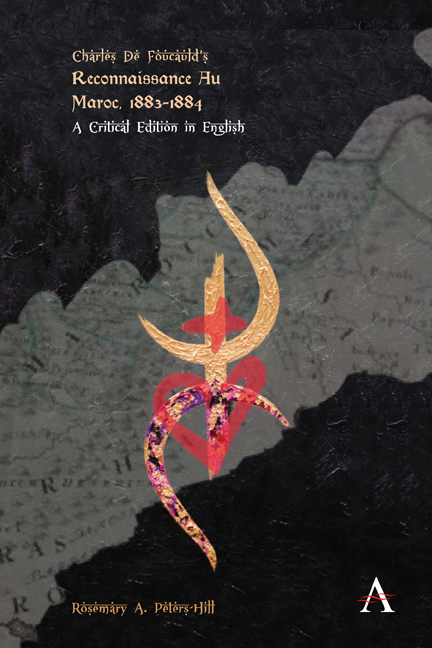Book contents
- Frontmatter
- Contents
- List of Figures
- Acknowledgments
- “There are no roads”: Charles de Foucauld’s Reconnaissance au Maroc—a Critical Introduction
- Charles de Foucauld, Reconnaissance au Maroc, 1883–1884
- Letter to François de Bondy
- Introduction
- Avant-Propos
- I Tangiers to Meknès
- II Meknès to Qaçba Beni Mellal
- III Qaçba Beni Mellal to Tikirt
- IV Tikirt to Tissint
- V Sojourn in the Sahara
- VI Tissint to Mogador
- VII Mogador to Tissint
- VIII Tissint to the Dadès
- IX The Dadès to Qçabi ech Cheurfa
- X Qçabi ech Chorfa to Lalla Maghnia
- Appendix: The Jews of Morocco
- Note on the Materials Used to Draw Up My Itinerary
- Report Delivered to the Société de Géographie de Paris in Its General Session of 24 April 1885
- “Itineraries in Morocco”
- Afterwards: An Afterword
- Glossary of Terms
- Bibliography
- Index
II - Meknès to Qaçba Beni Mellal
Published online by Cambridge University Press: 20 January 2022
- Frontmatter
- Contents
- List of Figures
- Acknowledgments
- “There are no roads”: Charles de Foucauld’s Reconnaissance au Maroc—a Critical Introduction
- Charles de Foucauld, Reconnaissance au Maroc, 1883–1884
- Letter to François de Bondy
- Introduction
- Avant-Propos
- I Tangiers to Meknès
- II Meknès to Qaçba Beni Mellal
- III Qaçba Beni Mellal to Tikirt
- IV Tikirt to Tissint
- V Sojourn in the Sahara
- VI Tissint to Mogador
- VII Mogador to Tissint
- VIII Tissint to the Dadès
- IX The Dadès to Qçabi ech Cheurfa
- X Qçabi ech Chorfa to Lalla Maghnia
- Appendix: The Jews of Morocco
- Note on the Materials Used to Draw Up My Itinerary
- Report Delivered to the Société de Géographie de Paris in Its General Session of 24 April 1885
- “Itineraries in Morocco”
- Afterwards: An Afterword
- Glossary of Terms
- Bibliography
- Index
Summary
Meknès to Bou El Djad
27 August 1883— I am finally leaving Meknès. We are leaving more numerous than I had thought: several people wanting to benefit from the company of my cherif have joined us. They are, first of all, six or eight poor Muslims going to the Tâdla, then two Jews from Bou el Djad going back home. And then, we will be on the road to Tlâta ez Zemmour with a caravan of about 50 merchants heading to the market there. Thus there are nearly 65 of us, and a single zetat to protect us all; he is a man of the Zemmour, Moulei Ez Zaïr.
Having left at eleven o’clock in the morning, we arrive around five-thirty in the evening at a little douar where we will spend the night. The landscape presents no difficulty during our travels: first we are in a plain, with many crops; from there we go into uneven terrain with no important hills—a very well-watered region, but sparsely farmed, covered in rather high lentisks, wild jujubes, and dwarf palms. Here we are in the land of the Zemmour Chellaha; the plain belonged to the Gerouân. The two tribes are of Tamazight race (chleuha) and rebellious; before long, we see some. The Gerouân have, with regard to travelers, the same system as some adjacent tribes of the blad el makhzen: they neither pillage nor give an anaïa, but, at every douar we pass through, we are stopped and made to pay an arbitrary duty, the zetata: a troop of horsemen and infantrymen comes to bar the road and exacts this fee with firearms at hand. In two hours, we dealt with five delegations of this kind. These are the only human beings we encountered on our road.
From the douar where we camp, we can see only mountains on all sides: to the south, the high embankment that forms the left flank of the Oued Beht valley; everywhere else, hilltops covered in dwarf palms or brush; all in all, a very hilly landscape. Such is the Zemmour Chellaha massif.
28 August.— Departure at three-thirty in the morning.
- Type
- Chapter
- Information
- Charles de Foucauld’s Reconnaissance au Maroc, 1883–1884A Critical Edition in English, pp. 151 - 184Publisher: Anthem PressPrint publication year: 2020



